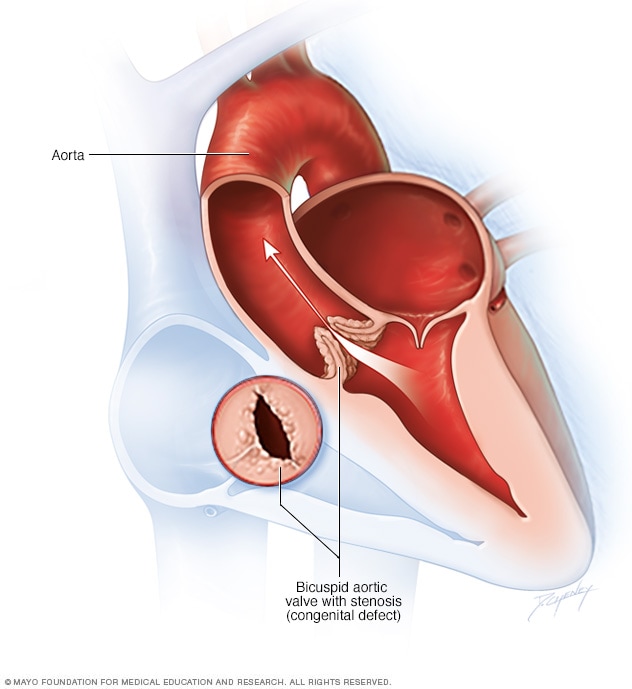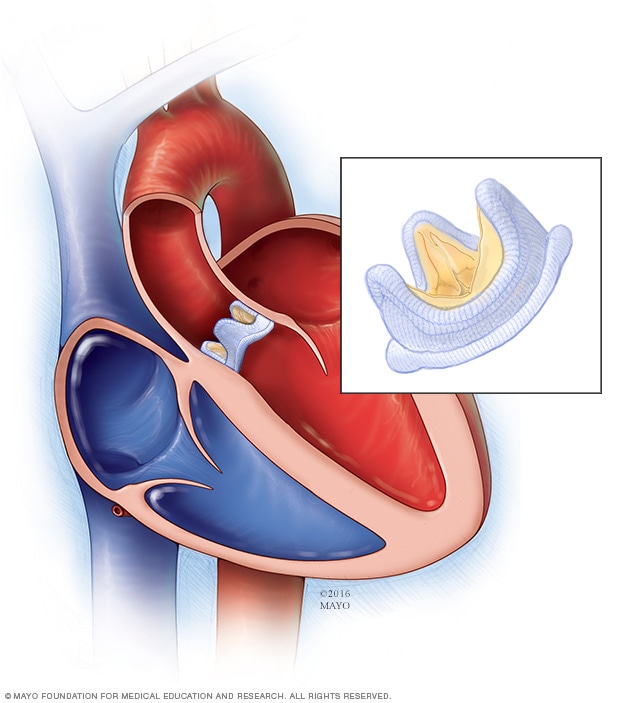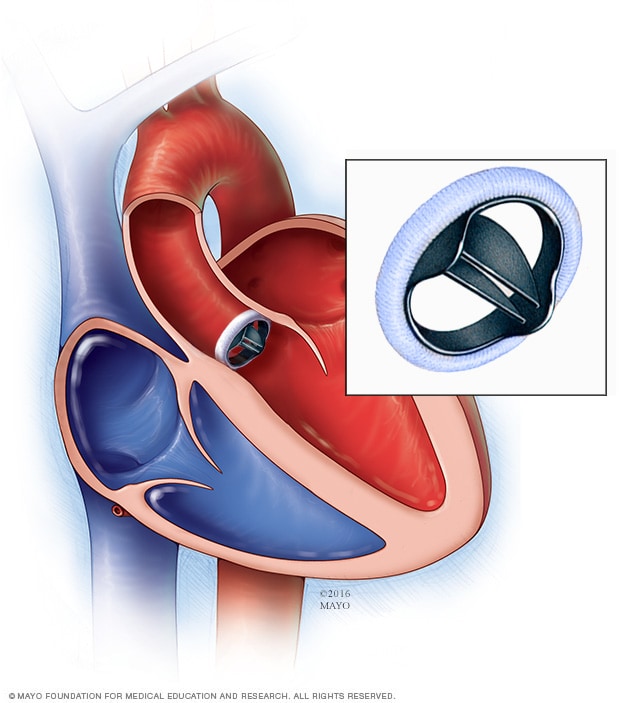Congenital heart defects in adults
Congenital heart defects in adults
Bicuspid aortic valve
Bicuspid aortic valve with stenosis

Bicuspid aortic valve with stenosis
A bicuspid aortic valve is an aortic valve that has two valves (leafs) instead of three. A narrowed or blocked aortic valve opening (aortic valve stenosis) can occur, making it difficult for the heart to pump blood into the body's main artery (aorta).
The bicuspid aortic valve is a congenital heart disease (congenital heart disease).
The aortic valve separates the left lower chamber of the heart (left ventricle) and the body's main artery (aorta). Tabs of tissue (sails) on the valve open and close with each heartbeat, ensuring that blood flows in the right direction.
Normally the aortic valve has three leaflets. A bicuspid valve only has two leaflets. In rare cases, some people are born with an aortic valve that has one leaflet (unicuspid) or four leaflets (quadricuspid).
A bicuspid aortic valve can cause heart problems including:
- Verengung der Aortenklappe (Aortenklappenstenose). Dadurch öffnet sich das Ventil möglicherweise nicht vollständig. Der Blutfluss vom Herzen zum Körper wird reduziert oder blockiert.
- Rückfluss von Blut (Aortenklappeninsuffizienz). Manchmal schließt die zweispitzige Aortenklappe nicht fest, wodurch das Blut zurückfließt.
- Vergrößerte Aorta (Aortopathie). Manche Menschen mit einer bikuspiden Aortenklappe haben eine vergrößerte Aorta. Eine vergrößerte Hauptschlagader erhöht das Risiko eines Risses in der Auskleidung der Hauptschlagader (Aortendissektion).
Symptoms
Most people with a bicuspid aortic valve have no signs or symptoms of valve disease until they are adults. However, severe symptoms can occur in infants. Symptoms of a bicuspid aortic valve include chest pain, shortness of breath, and difficulty exercising.
diagnosis
A bicuspid aortic valve may be discovered when you have medical tests for another health condition. Your doctor may hear a heart murmur when they listen to your heart with a stethoscope.
An echocardiogram is performed to confirm the diagnosis of bicuspid aortic valve. An echocardiogram uses sound waves to create video images of your heart in motion. It can show your doctor the aortic valve, aorta, heart chambers, and blood flow through your heart.
If you have a bicuspid aortic valve, a computed tomography (CT) scan is usually done to look for an enlarged aorta.
Treatment
If you have a bicuspid aortic valve, you will likely be referred to a doctor who specializes in congenital heart disease (congenital cardiologist).
Children and adults with a bicuspid aortic valve need regular medical examinations and echocardiograms to determine whether the valve is leaking (regurgitation), stiffening (stenosis), or an enlarged aorta.
Treatment depends on the extent of the heart valve disease. There are no medications to treat a bicuspid heart valve. However, your doctor may prescribe medication to treat related heart problems such as high blood pressure. You may need surgery for aortic valve stenosis, aortic valve regurgitation, or an enlarged aorta.
Operations or other procedures
Biological valve replacement

Biological valve replacement
In biological valve replacement, a valve made from cow, pig or human heart tissue replaces the damaged valve.
Mechanical valve replacement

Mechanical valve replacement
With mechanical valve replacement, a mechanical valve replaces the damaged valve.
Surgery may be necessary to repair or replace the aortic valve. The type of surgery performed depends on your specific condition and symptoms.
-
Aortic valve replacement.The surgeon removes the damaged valve and replaces it with a mechanical valve or a valve made from cow, pig, or human heart tissue (biological tissue valve). Another type of biological tissue valve replacement that uses your own pulmonary valve is sometimes possible.
Biological tissue valves break down over time and may need to be replaced. People with mechanical valves must take blood thinners for the rest of their lives to prevent blood clots. Your doctor will discuss the benefits and risks of each type of valve and which valve may be right for you.
- Chirurgie der Aortenwurzel und der aufsteigenden Aorta. Chirurgen entfernen den vergrößerten Abschnitt der Aorta in der Nähe des Herzens. Es wird durch ein synthetisches Rohr (Transplantat) ersetzt, das eingenäht wird. Manchmal wird nur der vergrößerte Abschnitt der Aorta entfernt und die Aortenklappe bleibt erhalten. Auch die Aortenklappe kann bei diesem Eingriff ersetzt oder repariert werden.
- Ballonvalvoplastik. Ihr Arzt kann dieses Verfahren empfehlen, wenn eine bicuspid Klappe eine Aortenstenose verursacht hat. Der Arzt führt einen Katheter mit einem Ballon an der Spitze in eine Arterie in Ihrer Leiste ein und führt ihn zur Aortenklappe. Der Ballon wird aufgeblasen, wodurch die Öffnung des Ventils erweitert wird. Die Luft wird dann aus dem Ballon abgelassen (deflationiert). Katheter und Ballon werden entfernt. Bei Erwachsenen, die sich dem Eingriff unterziehen, neigt die Klappe dazu, sich wieder zu verengen.
Lifelong care
After a bicuspid aortic valve is diagnosed, you will need lifelong evaluation by a cardiologist to monitor changes in your condition.
If you have a bicuspid aortic valve, you are more likely to develop an infection of the lining of your heart (infective endocarditis). Proper dental care can help reduce your risk.
A bicuspid aortic valve can be inherited (inherited) in families. For this reason, doctors often recommend screening parents, children, and siblings (first-degree relatives) of people with a bicuspid aortic valve with an echocardiogram.
Sources:
- Bonow RO, et al., Hrsg. Aortenklappenerkrankung. In: Herzkrankheit Braunwald: Ein Lehrbuch der Herz-Kreislauf-Medizin. 11. Aufl. Elsevier; 2019. https://www.clinicalkey.com. Abgerufen am 18. März 2021.
- Herzklappenerkrankung. Nationales Institut für Herz, Lunge und Blut. https://www.nhlbi.nih.gov/health/health-topics/topics/hvd. Abgerufen am 18. März 2021.
- Aortenklappenstenose (AVS) und angeborene Defekte. American Heart Association. https://www.heart.org/en/health-topics/congenital-heart-defects/about-congenital-heart-defects/aortic-valve-stenosis-avs#.WclzKdjrvcs. Abgerufen am 18. März 2021.
- Braverman AC. Klinische Manifestationen und Diagnose der bikuspiden Aortenklappe bei Erwachsenen. https://www.uptodate.com/contents/search. Abgerufen am 18. März 2021.
- Braverman AC. Bicuspide Aortenklappe: Allgemeines Management bei Erwachsenen. https://www.uptodate.com/contents/search. Abgerufen am 18. März 2021.
- Was ist ein Aneurysma? Nationales Institut für Herz, Lunge und Blut. https://www.nhlbi.nih.gov/health-topics/aneurysm. Abgerufen am 18. März 2021.
- Burke CR, et al. Management des thorakalen Aortenaneurysmas bei Erwachsenen. https://www.uptodate.com/contents/search. Abgerufen am 18. März 2021.
- Fragen Sie MayoExpert. Zweispitzige Aortenklappe. Mayo-Klinik; 2020.

 Suche
Suche
 Mein Konto
Mein Konto